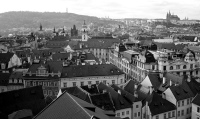
Tourists flock to the once communist city for history and entertainment. Courtesy of Flickr
By Pasquale Gianni
In Prague, the remaining signs of what was decades of communist rule are rapidly beginning to erode. 25 years later, the city is a magnet for bad behavior. Pick your poison: casinos, brothels, brew-pubs, illicit drugs or heavy food. These are not the characteristics that drew me to the charming Czech capital, though. The city itself has a rich history and boasts tremendous aesthetic diversity. The magnificent architecture, for example, ranges from Romanesque to Gothic, Renaissance, Baroque, Rococo, Neo-Renaissance, Neo-Gothic, Art Nouveau, Cubist, Neo-Classical and ultra-modern. It is a city that reminds me much of Budapest, and they share similar histories. Much of that history is still on display, everywhere you look. What is most surprising, though, is the city’s rapid transformation into a leading economic and business center in spite of that history.
“Praha,” as they call it, served as the Capital of the Kingdom of Bohemia (1198-1918) during which time it fell under control of the Holy Roman Empire and the Austro-Hungarian Empire, among others. The 14th century, more specifically the reign of Charles IV (1342–78), is considered the Golden Age of its history. Today you will find the Prague Castle, walled in and perched up on a hill, serves as a reminder, museum and point of pride for the glory days of Bohemia. As homage, most Czechs still refer to themselves as Bohemians, much like Southern German ‘Bavarians,’ even if they come from an area outside of what was considered Bohemian territory (modern-day Czech Republic encompasses more than just ancient Bohemia). They seem to milk it as much as they can, as everywhere you go there is some form of “traditional Bohemian fare” or “traditional Bohemian costumes” or “traditional recipe Bohemian pilsner beer.”
The Czechs are very good at remembering, taking pride and profiting off of this part of their history. The 75 years to follow are not so much. The Czechoslovak Republic formed in 1918 in the aftermath of World War I as a Democratic Republic, although with a strong communist presence. It was annexed by Nazi Germany and technically ceased to exist during World War II. After all the dust settled in 1945, what followed was 45 years of (not necessarily) uninterrupted communist rule in the Soviet-dominated eastern-bloc. In 1968, party leader Alexander Dubcek proposed reforms that included a democratic process and this led to the invasion of Czechoslovakia by the Soviet Union. Under pressure from Moscow, all reforms were repealed, party leadership was taken over by more authoritarian wing and a massive non-bloody purge of party members was conducted. In 1989, during what was known as the ‘Velvet Revolution’, the first democratic elections were held and the communist party was ousted in what became the collapse of planned economies all over Europe. Four years later, the country would peacefully split into Slovakia and the Czech Republic, where Prague remains the vibrant capital.
Today the city boasts tall, quasi-skyscrapers, big foreign banks and familiar businesses (there are KFC’s everywhere, strangely), and a bustling and growing, tourism sector. Tucked away in a corridor of an old building next to a casino, ironically, is the ‘Museum of Communism.’ It holds an over exaggeratedly drab and musty display of recreated history through props, video and posters serving as a reminder of an era most Czechs choose to overlook. They would rather be remembered as Bohemians than communists. Being proud or, sometimes, ashamed of your history is something we should all be able to appreciate. What is better, however, is the growing number of young Czechs who proudly refer to themselves as only Czech. They have seen the incredible transformation and subsequent prosperity of their renewed nation of 23 years and take great pride in it, as they should. Such is the beauty of history in motion.
